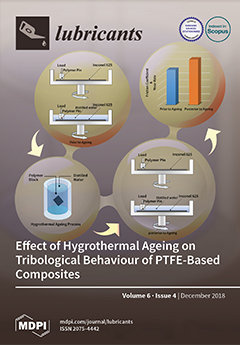This study is focused on the reduction of CO
2 emissions and costs associated with ultra-low viscosity (ULV) engine oils for passenger vehicles. Specifically, the reduction in life cycle CO
2 (LCCO
2) emissions from lower-viscosity engine oil and the oil drain interval (ODI) extension were estimated taking into account both mineral engine oil and synthetic engine oil. Furthermore, the cost-effectiveness of ULV engine oils were investigated by performing base-stock cost analysis. When the volatility limit of the Noack test (American Society for testing and materials (ASTM) D5800) was set to 15 wt %, the results indicated that the lower limit of kinematic viscosity at 100 °C (KV100) for mineral engine oil (with Group-III base-stock) and synthetic engine oil (with polyalphaolefin (PAO) base-stock) were approximately 5.3 and 4.5 mm
2/s, respectively. Compared to conventional 0W-16 mineral engine oil (KV100 6.2 mm
2/s), the effect of reducing LCCO
2 emissions on ULV mineral engine oil (ULV-Mineral, KV100 5.3 mm
2/s) was estimated at 0.6%, considering 1.5–1.8 L gasoline engines in New European Driving Cycles (NEDC) mode. ULV-Mineral, which continues to use a mineral base-stock, is considered highly cost-effective since its cost is similar to the conventional 0W-16 mineral engine oil. On the other hand, compared with ULV-Mineral, the vehicle fuel efficiency improvement from the use of ULV synthetic engine oil (ULV-PAO, KV100 4.5 mm
2/s) was estimated to be 0.5%. However, considering CO
2 emissions during engine oil production, the reduction of LCCO
2 emission from ULV-PAO compared with ULV-Mineral was estimated to be only 0.1% or less using 2030 standards (assuming a vehicle fuel efficiency of 66.5 g-CO
2/km) when ODI is set equivalent (7500 km) to mineral engine oil. As a result, ULV-PAO’s cost-effectiveness, considering the cost increase of PAO base-stock, was found to be nominal. Contrariwise, when the characteristics of PAO base-stock with higher oxidation stability are used comparatively with the mineral base-stock while extending the ODI to 15,000 km, the effect of reducing LCCO
2 emissions of ULV-PAO was estimated to be 0.7% in 2030, making ULV-PAO a competitive and cost-effective alternative. In other words, the popularization of synthetic engine oil toward 2030 will require the consideration of both viscosity reduction and ODI extension.
Full article





